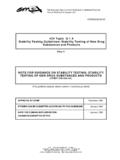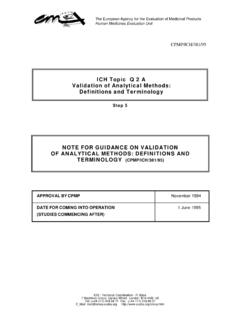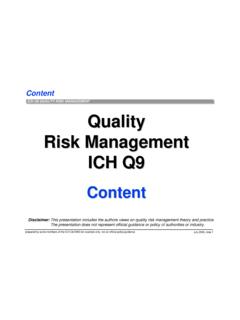Transcription of ICH Topic Q 3 A Impurities Testing Guideline: Impurities ...
1 The European Agency for the Evaluation of Medicinal ProductsHuman Medicines Evaluation UnitICH - Technical Coordination - R. Bass7 Westferry Circus, Canary Wharf, London E14 4HB, UKTel: (+44-171) 418 84 11 Fax: (+44-171) 418 85 51E_Mail: Topic Q 3 AImpurities Testing Guideline: Impurities in New DrugSubstancesStep 5 NOTE FOR GUIDANCE ON Impurities Testing : Impurities IN NEW DRUG SUBSTANCES (CPMP/ICH/142/95)APPROVAL BY CPMPMay 1995 DATE FOR COMING INTO OPERATION(STUDIES COMMENCING AFTER)1 November 1995 CPMP/ICH/142/951/11 Impurities IN NEW DRUG SUBSTANCESICH Harmonised Tripartite GuidelineTABLE OF of Impurities for the Reporting and Control of Impurities Organic Impurities Inorganic Impurities Solvents Impurity Content of Batches Limits for Impurities of Impurities Impurities I - "Decision Tree for Safety Studies 10 CPMP/ICH/142/952/11 Impurities IN NEW DRUG SUBSTANCESICH Harmonised Tripartite Guideline[EMEA Status as of May 1995]
2 Document is intended to provide guidance for registration applications on the content andqualification of Impurities in new drug substances produced by chemical syntheses and notpreviously registered in a region or member state. It is not intended to apply to the regulationof new drug substances used during the clinical research stage of , peptide, oligonucleotide, radiopharmaceutical, fermentation andsemi-synthetic products derived therefrom, herbal products, and crude products of animal orplant origin are not covered. Impurities in new drug substances are addressed from two perspectives:Chemistry Aspects includes classification and identification of Impurities , reportgeneration, setting specifications, and a brief discussion of analytical procedures; and,Safety Aspects includes specific guidance for qualifying Impurities which were notpresent in batches of new drug substance used in safety and clinical studies and/orimpurity levels substantially higher than in those batches.
3 Threshold limits are defined,below which, qualification is not OF IMPURITIESI mpurities may be classified into the following categories: Organic Impurities (Process and Drug Related) Inorganic Impurities Residual SolventsOrganic Impurities may arise during the manufacturing process and/or storage of the new drugsubstance. They may be identified or unidentified, volatile or non-volatile, and include: Starting Materials By-Products Intermediates Degradation Products Reagents, Ligands and CatalystsInorganic Impurities may derive from the manufacturing process. They are normally knownand identified and include: Reagents, Ligands and CatalystsCPMP/ICH/142/953/11 Heavy Metals Inorganic Salts Other Materials ( , Filter Aids, Charcoal, etc.)
4 Solvents are organic or inorganic liquids used during the manufacturing process. Since theseare generally of known toxicity, the selection of appropriate controls is easily from this document are: extraneous contaminants which should not occur in newdrug substances and are more appropriately addressed as GMP issues; polymorphic form, asolid state property of the new drug substance; and, enantiomeric FOR THE REPORTING AND CONTROL OF Impurities ImpuritiesThe applicant should summarise those actual and potential Impurities most likely to ariseduring the synthesis, purification, and storage of the new drug substance.
5 This summaryshould be based on sound scientific appraisal of the chemical reactions involved in thesynthesis, Impurities associated with raw materials which could contribute to the impurityprofile of the new drug substance, and possible degradation products. This discussion mayinclude only those Impurities that may reasonably be expected based on knowledge of thechemical reactions and conditions addition, the applicant should summarise the laboratory studies conducted to detectimpurities in the new drug substance. This summary should include test results of batchesmanufactured during the development process and batches from the proposed commercialprocess, as well as results of intentional degradation studies used to identify potentialimpurities arising during storage.
6 Assessment of the proposed commercial process may bedeferred until the first batch is produced for marketing. The impurity profile of the drugsubstance lots intended for marketing should be compared with those used in development andany differences studies conducted to characterise the structure of actual Impurities present in the newdrug substance at or above an apparent level of ( , calculated using the response factorof the drug substance) should be described. Note that all recurring Impurities at or above level in batches manufactured by the proposed commercial process should be products observed in stability studies at recommended storage conditions shouldbe similarly identified.
7 When identification of an impurity is not feasible, a summary of thelaboratory studies demonstrating the unsuccessful effort should be included in the attempts have been made to identify Impurities below the level, it is useful toalso report the results of these studiesIdentification of Impurities below apparent levels of is generally not considerednecessary. However, identification should be attempted for those potential Impurities that areexpected to be unusually potent, producing toxic or pharmacologic effects at a level lower In all cases, Impurities should be qualified as described later in this guide.
8 Although it iscommon practice to round analytical results of between and to the nearest numberCPMP/ICH/142/954/11( , ), for the purpose of these guidelines , such values would not be rounded to these Impurities would not require ImpuritiesInorganic Impurities are normally detected and quantitated using pharmacopoeial or otherappropriate procedures. Carry-over of catalysts to the new drug substance should beevaluated during development. The need for inclusion or exclusion of inorganic Impurities inthe new drug substance specifications should be discussed. Limits should be based onpharmacopoeial standards or known safety control of residues of the solvents used in the manufacturing process for the new drugsubstance should be discussed.
9 Any solvents which may appear in the drug substance shouldbe quantified using analytical procedures with an appropriate level of or other appropriate procedures should be utilised. Limits should be based onpharmacopoeial standards or known safety data taking into consideration dose, duration oftreatment, and route of administration. Particular attention should be given to quantitation oftoxic solvents used in the manufacturing PROCEDURESThe registration application should include documented evidence that the analyticalprocedures are validated and suitable for the detection and quantitation of in the analytical procedures used during development and proposed for thecommercial product should be discussed in the registration impurity levels can be measured by a variety of techniques.
10 Including those whichcompare an analytical response for an impurity to that of an appropriate reference standard orto the response of the new drug substance itself. Reference standards used in the analyticalprocedures for control of Impurities should be evaluated and characterised according to theirintended uses. It is considered acceptable to use the drug substance to estimate the levels ofimpurities. In cases where the response factors are not close, this practice may still beacceptable, provided a correction factor is applied or the Impurities are, in fact, beingoverestimated. Specifications and analytical procedures used to estimate identified orunidentified Impurities are often based on analytical assumptions ( , equivalent detectorresponse, etc.)




